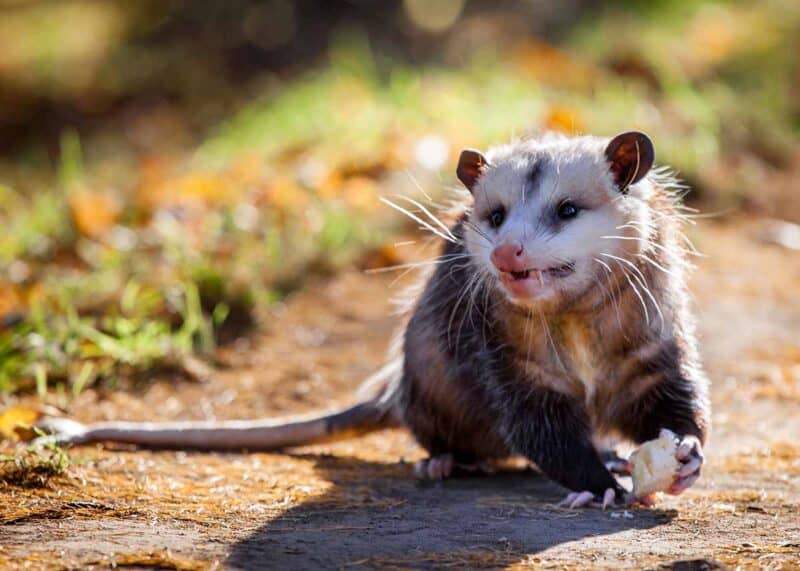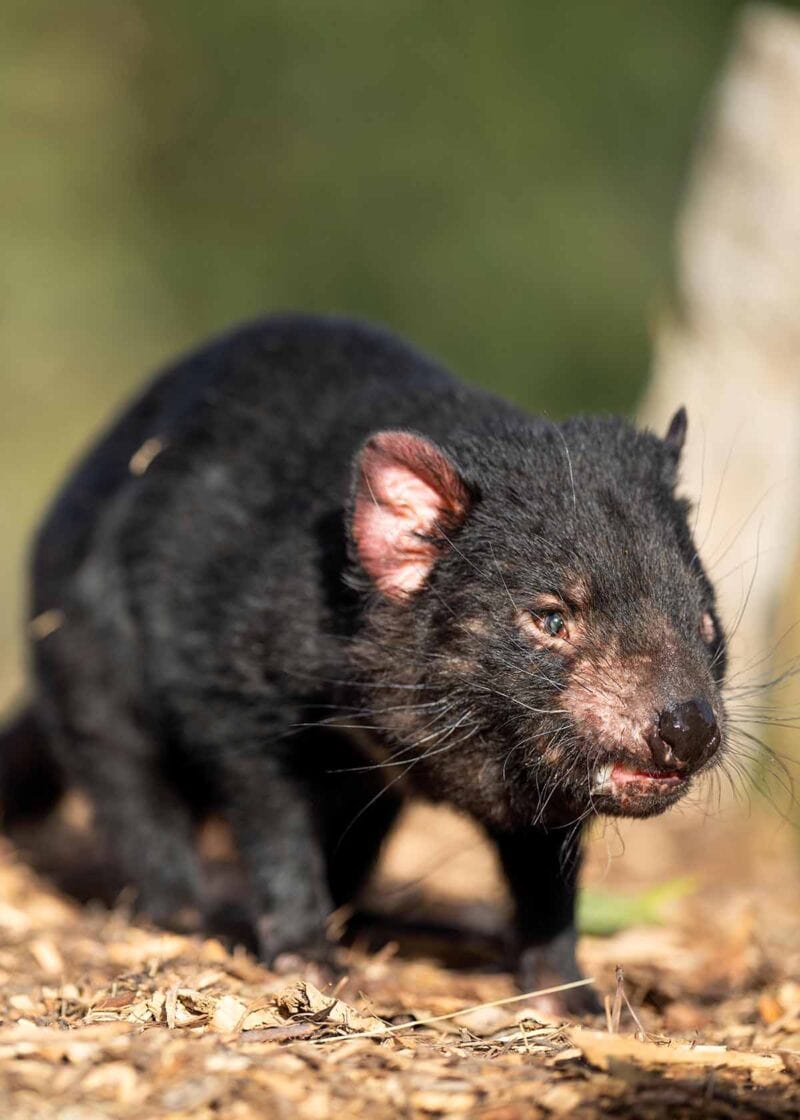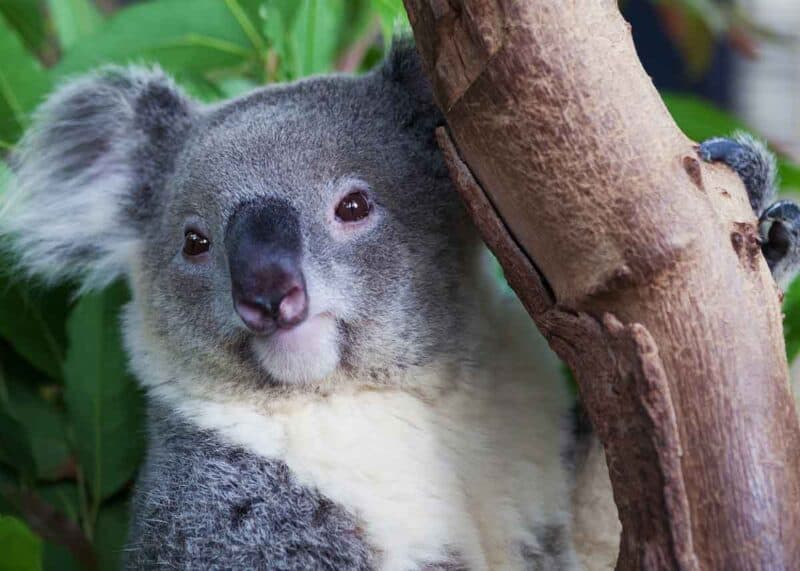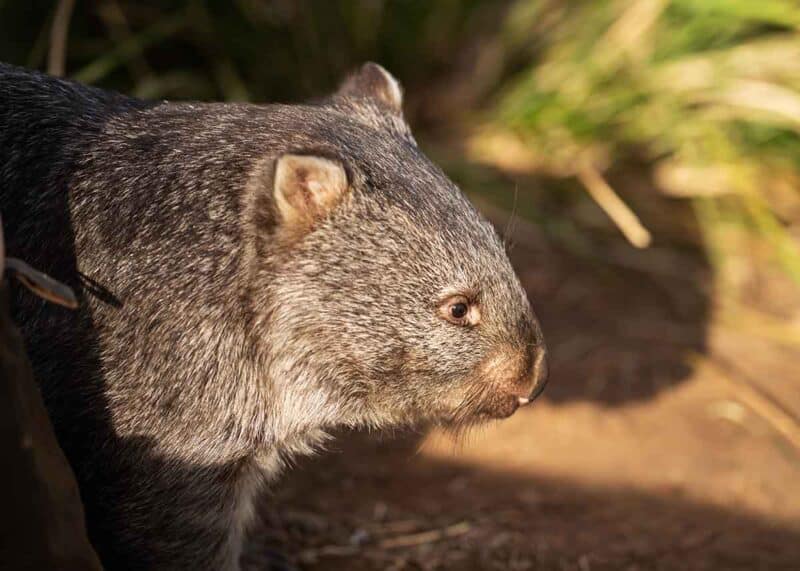Many animals have pouches. You might think of kangaroos. But can you name more animals with pouches?
Animals with pouches are called marsupials. They include gliders, opossums, possums, kangaroos, wombats, koalas, and the Tasmanian devil. In all, there are 334 species of marsupials. They live on the Australian continent and the Americas.

This guide is part of a series about animal reproduction, including 26 Animals that Lay Eggs.
Table of Contents
Animals with Pouches: All 334 Extant Species
Marsupials are animals with pouches in the mammalian infraclass Marsupialia. These animals use their pouches to birth, protect, and carry their young.
And this is where the similarities end. Some marsupials are giant, like the kangaroo, while others are small tree dwellers, such as gliders and possums.
How Many Marsupials Live in Australia?
About 70% of the extant (non-extinct) species live in Australia (including Tasmania, New Guinea and various islands). The other 30% live in the Americas, with the majority of these in South America.
Only 13 species are found in Central America. And north of Mexico, there is just one marsupial species: Virginia opossum.
Read on to learn about the various animals known as marsupials.
American Opossums (93 Species)
American opossums are classified under the Order Didelphimorphia.
Opossums are part of the Didelphidae family and Didelphis genus, which differ from Australian possums.
93 different species of these marsupials live in North America and South America. Those species exist in many genera and subfamilies of the wider Didelphidae family.

People who live in North America are likely most familiar with the large and white Virginia opossum. However, there are plenty of opossum species that look a bit different.
Caluromys philander, commonly known as bare-tailed woolly opossum, is a small gray opossum found in South American trees.
Order Microbiotheria (1 Species)
Monito del monte (or colocolo opossum) is native to Argentina and Chile, in South America. It is the only species remaining in the Family Microbiotheriidae.
Monitos del monte are small, tree-loving marsupials. They hibernate, like many mammals in cold climates.
Order Paucituberculata (7 Species)
Seven species of the tiny shrew opossum can be found in South America. They all belong to Family Caenolestidae.
Order Notoryctemorphia (2 Species)
These two marsupial moles are in the Family Notoryctidae.
- Southern marsupial mole: Known locally as itjaritjari
- Northern marsupial mole: Also known as kakarratul
Dasyuromorphia (73 Species)
In the order Dasyuromorphia, there are 73 species. They all are in the Dasyurid family, except for the numbat (Myrmecobius fasciatus), which is in the Family Myrmecobiidae.

Dasyurids (72 Species)
Dasyurids comprise a large group of marsupials native to Australia and New Guinea. Since there are 72 Dasyurid species, it is not surprising that there is a wide range of characteristics to be found across this family.
The Dasyuridae includes the larger 18-pound Tasmanian devil and the mouse-sized Pilbara ningaui, which weighs between .07 and .3 ounces.
Members of this family live in a range of habitats, including forests, burrows, grasslands, and partially aquatic environments.
Despite these differences, there are a few qualities commonly found across this family. They are usually carnivorous, often primarily eating insects.
Bandicoots and Bilbies (27 Species)
There are 27 bandicoot and bilby (rabbit-bandicoot) species within the Peramelemorphia order. They are native to New Guinea and Australia. These tiny animals are known for their long shrew-like snouts and small size.
Depending on the specific species, they can reach a weight between half a pound and three and a half pounds. They can be between 10 and 30 inches long, including a long tail. Their fur can be white, black, gray, tawny, or gray.
Diprotondontia (136 Species)
This is the largest order of marsupials. The species in this order includes wombats, koala, possums, sugar gliders, kangaroos, wallabies, and rat-kangaroos.
Brushtail Possums and Cuscuses (27 Species)
Brushtail possums and cuscuses are both parts of the Phalangeridae family. Members of this family live throughout Australia, New Guinea, and Indonesia. Wherever they live, most members of this family love spending their time in the trees. There are 27 different Brushtail possum and cuscus species within six genera.
These species range in size from 12 to 29 inches long. The larger members of the family can weigh around 10 pounds. They can have a range of fur colors, including grey, brown, and black. That fur is usually quite dense.

Macropodidae (54 Species)
This family contains larger marsupial groups, such as kangaroos, wallabies, wallaroos, pademelons, quokkas, and tree-kangaroos. Fifty-four species and 11 genera make up this family.
The members of this family are native to Australia and New Guinea. Most macropods are herbivorous, though the family has some omnivorous members in its ancestry.
Pademelons and quokkas are some of the smallest members of this group, while kangaroos are the largest. Despite this size range, macropods have some consistent traits amongst them.
They usually have long, narrow back feet, small heads, and large ears. Those big back feet allow this family to jump far distances with ease.
Koalas (1 Species)
Koalas are the only extant member of the Phascolarctidae family. There are also 11 known fossil species of that same family.
While these marsupials are often called bears, they are unrelated to other bears. This association likely comes from the Greek origin of its name. Like many marsupials, koalas are native to Australia.

As an arboreal herbivore, Koalas primarily live on eucalyptus leaves. They are relatively sedentary, sleeping around 20 hours each day.
These marsupials have dense grey or brown fur, no tail, fluffy ears, and an ovular nose. They can measure approximately 30 inches long and weigh between 10 and 30 pounds.
Since koalas depend on the specific eucalyptus-based arboreal habitat, they are quite vulnerable to habitat destruction and climate change. As a result, this species is endangered.

Wombats (3 Species)
Wombats are the koala’s closest living relative. As a result, the two marsupial groups have a lot in common. These marsupials include three extant species that make up the Vombatidae family. There are at least seven extinct members of the family.
All wombats are native to Australia and the surrounding areas.
The common wombat, also known as Vombatus ursinus, is the sole extant member of the Vombatus genus. The other genus within the Vombatidae family is Lasiorhinus which contains two species. Those species include Lasiorhinus latifrons, the Southern hairy-nosed wombat, and Lasiorhinus krefftii, the Northern hairy-nosed wombat.
While these animals have some key differences, there are also several similarities across the species. Wombats are skilled diggers, aided by their large front teeth and strong claws. These species are known for their cube-shaped feces. These herbivores primarily eat roots, grass, sedges, bark, and herbs. All three extant species measure around three feet in length and weigh between 40 and 80 pounds.
Learn more about animals that eat grass.
Petauroidea (30 Species)
The Petauroidea family of marsupials includes about 30 small animal species, including gliders, striped possum, mahogany glider, and yellow-bellied glider. Most members of this superfamily are arboreal. Four families make up this superfamily.
The Pseudocheiridae family includes 17 extant species, including ringtailed possums. Eleven possum species make up the Petauridae family, including some striped possums and trioks. The Tarsipedidae family consists of a single species: the honey possum.
Those tiny marsupials are important pollinators throughout southwestern Australia. The Acrobatidae family includes two species, known as the feathertail glider and the feather-tailed possum.
With so many members of this superfamily, there is a fair amount of variance. However, there are reasons for all these species being classified together. Many members of this superfamily have wings ideal for gliding or vestigial wings. These animals are also reasonably small, native to Australia and New Guinea, and prefer an arboreal habitat.
Other Species (21 Species)
The remaining 21 species in the Diprotondontia order include pygmy possums, honey possums, rat kangaroos, potoroos, and ringtailed possums.
More reading: Epic Guide to Weird Animals
Marsupials have unique adaptations that allow them to give their offspring protective care. Some animals create a safe environment for their babies, while others gestate for long periods. Animals use their pouches to perform both of those tasks.
Frequently Asked Questions
Here are some common questions about animals with pouches.
Where do marsupials live?
Most marsupials are native to the Australian and New Guinean areas. However, there are several marsupials, primarily in the Didelphidae family, who live in North America and South America.
Within those regions, marsupials enjoy a range of types of habitats.
How do marsupial pouches work?
Marsupial pouches vary slightly from species to species. For example, a wombat’s pouch faces its rear to prevent dirt from getting in while the animal digs. However, most marsupial pouches operate similarly. Female marsupials give birth to their young earlier in gestation than placental mammals.
After birth, the baby lives in the pouch and continues development while feeding using its mother’s teat. Depending on the species, a baby marsupial, or joey, may spend around a year in the pouch. That period can last between 12 and 40 days. The joey will emerge once it can manage its temperature regulation and feed itself.
Do any animals have pouches other than marsupials?
Animals with pouches are rare outside of the marsupial family. However, there are a few other animals who have pouches.
Echidnas, which are monotremes, and male seahorses, which are Syngnathiformes, both have gestational pouches. They operate slightly differently from marsupial pouches.
Sea otters have pouches. However, those spaces often get used for storage rather than gestation.
Final Thoughts
So, the next time you see animals with pouches, you will be able to identify them as marsupials.
From the species that jump through the wilds of Australia to the tree-enthusiasts that love raiding your trash, there is no shortage of pouch-wielding mammals who populate the earth.
Drew Haines is an animal enthusiast and travel writer. She loves to share her passion through her writing.
She graduated high school at sixteen and started her own business, Everywhere Wild Media. And she runs Everywhere Wild and JustBirding. She also guest blogs on Storyteller.Travel
She lived in Ecuador for 6 years and explored the Galapagos Islands. Currently based in N.S., Canada.
